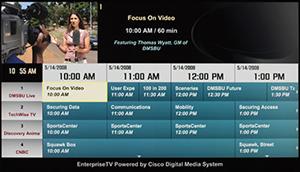

It’s the Network
As AV and IT applications converge and acquire the characteristics of each other, so too do the products themselves. For example, networking giant Cisco Systems, already highly recognized in telepresence, also offers what it considers digital signage systems.
AS AV AND IT APPLICATIONS CONVERGE and acquire the characteristics of each other, so too do the products themselves. AV gear takes on IT features, and networking hardware not normally considered AV equipment, suddenly is. For example, networking giant Cisco Systems, already highly recognized in telepresence, also offers what it considers digital signage systems.One Digital Media Player can power a single digital display or a videowall; Cisco doesn’t provide displays, but the players are compatible with any brand and support a variety of formats and codecs, broadcasting up to full HD. The IP-based hardware offers up to 4GB of storage and supports MPEG-4/H.264 and Adobe Flash 9 for dynamic content.
Since releasing its Digital Media System (DMS) in January 2007, it remained quietly under the radar until June 2008 when it rolled out the new Cisco DMS 5.0, which not only underscores Cisco’s digital signage chops, it also provides a platform for network-based live and on-demand video.
DMS 5.0 is the flagship of Cisco’s new business video strategy, providing an all-in-one resource of digital signage, video-on-demand, and desktop video. The company believes that businesses are heading toward more video-centric communications and wants to ensure it happens over a Cisco network.
“Cisco is obviously investing very heavily in a range of video solutions as well as optimizing our networks for video and providing services for customers so they can build interesting and innovative new types of business solutions that take advantage of video,” says David Hsieh, senior director of emerging technologies at Cisco.
DMS 5.0 offers three main video capabilities: digital signage, live or on-demand desktop video, and the much-touted Enterprise TV, which acts as a channel guide for networked video files. Signage is powered by the Cisco Digital Media Player. “With Enterprise TV, you have the opportunity now to let customers decide which videos they would be interested in looking at,” Hsieh explains. One example might be a home improvement store. Rather than displaying management-chosen advertising, a sign could let a customer choose from a menu of short DIY videos.
The Desktop Video feature is for on-demand or live viewing of video from a PC and includes viewing security options, usage reporting, and the ability to embed videos into Web pages. All in all, the DMS 5.0 comprises the media player appliance, the video distribution management software, and the video portal software necessary for on-demand viewing of video on the desktop.
Because DMS 5.0 uses a company’s network as a platform, it may require a network upgrade, from which Cisco would benefit. “Cisco is a networking equipment vendor,” points out Kris Vollrath, vice president of Advanced AV in West Chester, Pa., and PRO AV columnist. “[Its] solution heavily relies on an infrastructure that is designed to efficiently manage data resources, namely video and images.”
During a Cisco Webcast about DMS 5.0, Marthin De Beer, Cisco’s senior vice president of emerging technologies, stressed the need for businesses to make their networks “video-ready” to keep up with the rapidly advancing technology and popularity of digital video. Vollrath adds, “The shear amount of data that could potentially support a video-centric digital signage solution on a network is staggering and thus would require a content delivery network (CDN). The way most other enterprise digital signage solution providers do this is store and forward the content to edge distribution nodes and/or just [media] players. These solutions can also receive streaming content, but that would require a CDN to be efficient in a WAN environment.”
While DMS 5.0 may be cost efficient because it essentially contains three video systems in one, it may only benefit those that already have a video-enabled network and can take advantage of all three features. Vollrath points out that not everyone wants so many video solutions. In most cases, he doubts small- to medium-sized business will front the expense of a digital signage network that offers more than what they need, especially when the extra features may require them to upgrade their entire network.
“Where [Cisco] will play for the short-term will be in large clients that either already have an efficient network, or are in need of one and digital signage will be one of many applications utilizing this type of network,” he predicts.
According to Hsieh, Cisco has already attracted more than 600 clients since launching the first DMS last year. How can AV installers get a piece of the DMS action? Hsieh encourages them to attend Cisco’s Academy of Digital Signage and become qualified. “[Companies] can send people to the Academy of Digital Signage [to] become a content producer and not only provide the physical deployment and implementation services for their customers—and obviously reselling the equipment solution—but also provide services around content creation.” Installers lacking the time or interest to invest in content development could become Cisco channel partners. Channel partners provide installation, deployment, and ongoing services for DMS—a system sure to receive attention that’s been a year in coming.










